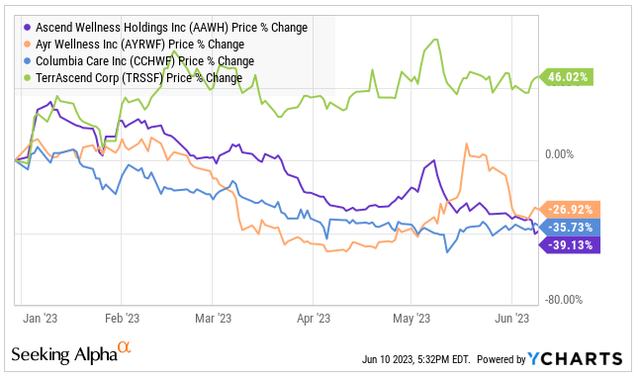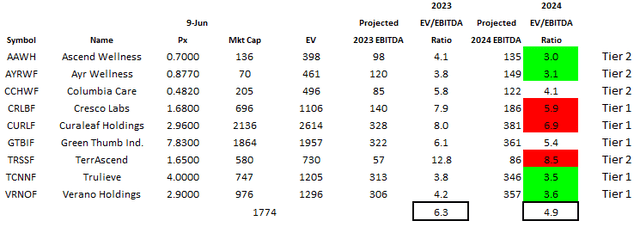In mid-March, I wrote about Ascend Wellness (OTCQX:AAWH) after its Q4 call and called it a stock that could double from the $1.15 where it was trading. Since then, it has reported its Q1, and the outlook has been stable. The price, though, has plunged to an all-time low near $0.70. I have added it to both of my model portfolios and have boosted the position to more than 5% of my Beat the Global Cannabis Stock Index model portfolio and more than 22% of my Beat the American Cannabis Operator Index model portfolio.
In today’s look, I evaluate its Q1 and the 2023 and 2024 outlooks, I assess the stock chart, I compare its valuation to its peers, I examine management changes, and I share why I think it is more likely to be acquired by another MSO.
Q1 Results
Revenue grew 34% to $114.2 million. Gross profit expanded 52%, with a gross margin of 31.3% relative to the 27.6% a year ago. Operating expenses fell 7%. Excluding a $5 million settlement expense included a year ago, they increased just 7%. The start of adult-use in New Jersey helped to drive the growth as did increased wholesaling of its products to other MSOs.
Adjusted EBITDA of $23.3 million grew 42.4% from the prior year. One part of the results that I liked was that the company moved from cash-flow use to generation during the quarter. In fact, the $5.8 million cash flow from operations exceeded the $3.4 million in capital expenditures.
Financial Outlook
The analysts expect the company to grow revenue in 2023 by 18% to $478 million. Adjusted EBITDA is expected to be $98 million. In 2024, six analysts forecast revenue will increase 16% to $554 million with adjusted EBITDA of $135 million.
These estimates are a bit better than what was expected ahead of the Q1 report for 2024. Analysts had been forecasting revenue of $550 million with adjusted EBITDA of $136 million. Ahead of the Q4 report, numbers had been much higher. Then, analysts were looking for revenue of $604 million and adjusted EBITDA of $155 million in 2024.
The Chart
AAWH posted a new all-time closing low of $0.684 on Thursday, and it rallied to $0.70 on Friday while setting a new all-time intraday low of $0.61. It dropped 13.6% last week and is down 39.1% in 2023. It dropped 82.5% in 2022.
Charles Schwab StreetSmart edge
The stock has sold off on light volume, and there is no clear sign that the bottom is in yet.
Here is the year-to-date chart relative to the Tier 2 peers:
YCharts
The stock has dropped the most of the four and almost twice as much as the New Cannabis Ventures Global Cannabis Stock Index, which is down 21.1%.
The Valuation
Ascend has a very low valuation at just 3X enterprise value to projected adjusted EBITDA in 2024, the lowest among the top MSOs:
Alan Brochstein using Sentieo
In that last piece, I shared a year-end target of $2.24 based on achieving a 5X enterprise value to projected 2024 adjusted EBITDA. I was assuming then that the adjusted EBITDA would be lower than the analysts were forecasting at the time and be $134 million. They currently are lower but near my forecast. Using their estimate of $135 million and my target multiple yields an enterprise value of $675 million. Subtracting net debt of $263 million results in a stock price of $2.04, which is lower than my prior target but still 191% higher. The 5X multiple is a big discount to what I use for the Tier 1 names.
Management Changes
In mid-May, the former President of BuyBuy Baby and CEO of True Value Company, John Hartmann, became CEO. He didn’t speak on the Q1 conference call. Russel Reynolds led the search. Recall that founder Abner Kurtin resigned his position of CEO and became Executive Chairman in late 2022. The company also appointed Sam Brill to the Board of Directors. Brill has a background in cannabis debt investing.
I am not yet excited by these changes, as I realize that the CEO comes from outside of industry, but I also don’t see anything besides a potentially challenging learning curve. The two executives who were serving on an interim basis as co-CEOs are remaining with the company as is Executive Chairman Kurtin. I think that the compensation for the new CEO was quite high. Hartmann will receive a salary of $950K per year with a bonus potential of that much annually too. He received 6 million restricted stock units too. 4 million of those RSUs are tied to performance.
Potential M&A Target
Cannabis M&A is challenging at this time. The combined companies must meet the criteria of regulators in many states. One thing that is nice about Ascend is that it operates in just a few states. The two that can be a regulatory challenge are Illinois, which limits the number of dispensaries, and Massachusetts, which limits both the number of dispensaries and the size of the production facilities. Its other states are Maryland, Michigan and New Jersey.
I have never counted on a quick acquisition of the company, but the moves made by Trulieve (OTCQX:TCNNF) to get out of Massachusetts open the door to a potential Trulieve purchase of Ascend. Trulieve doesn’t operate in Illinois, and Ascend isn’t in Pennsylvania, a big state for Trulieve. Trulieve isn’t in New Jersey either. One factor that argues against a move in the near-term is that Trulieve stock is very beaten up. I said last week that it offers an excellent entry for investors in cannabis companies. So, this is something to watch if perhaps Trulieve recovers and Ascend doesn’t.
There could be other potential buyers too, especially if Canopy Growth (CGC)(WEED:CA) pulls off its plan to retain its NASDAQ listing while acquiring American cannabis companies. This would open the door to some cash-rich debt-free Canadian LPs to enter the U.S. with an acquisition.
Conclusion
I find Ascend very attractive relative to its peers. One thing that I really like is that the AdvisorShares Pure US Cannabis ETF (MSOS), which has been seeing redemptions in shares over the past six months, owns none. So, continued redemptions could weigh on other stocks, primarily the six names that make up 86% of the holdings. I also think that it could be acquired, potentially by Trulieve, though M&A activity is pretty constrained right now. My target, though, without an acquisition, is nearly three times higher than the current depressed price of $0.70.
Editor’s Note: This article discusses one or more securities that do not trade on a major U.S. exchange. Please be aware of the risks associated with these stocks.
Read the full article here












